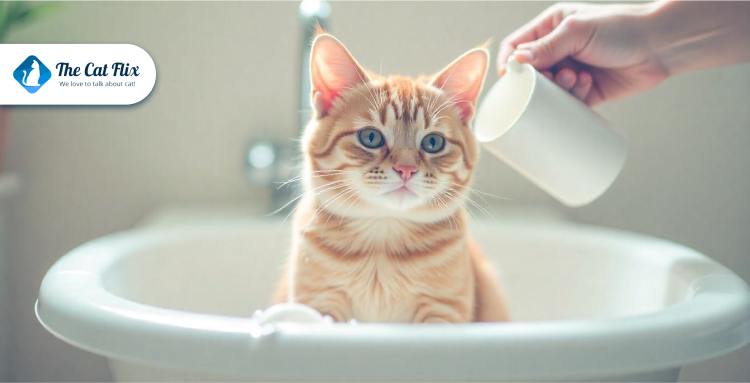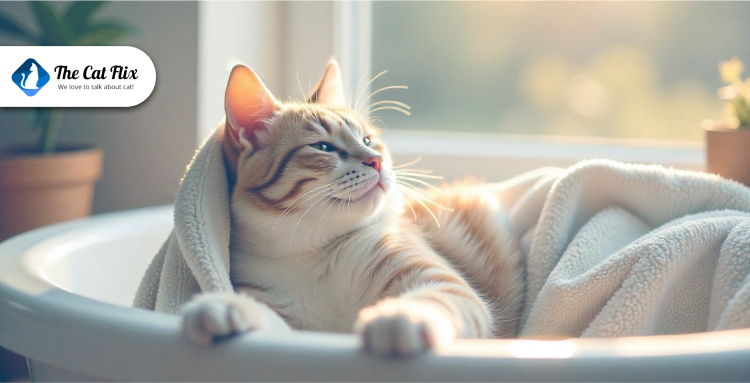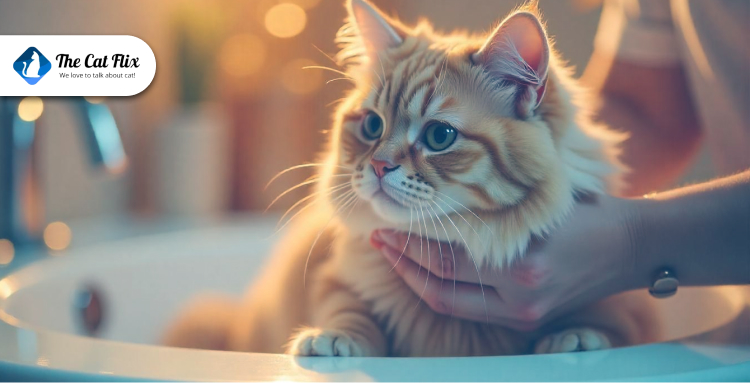There are two things in this world you never want to do unless absolutely necessary: borrow your cat’s favorite blanket… and try to give them a bath.
Now, if you’re here, chances are you’ve got a sensitive little furball who treats water like it’s the enemy, and you’re wondering if there’s a way to clean them without emotional or physical scarring (for either of you).
Maybe they’ve rolled in something questionable. Maybe they’re older and can’t groom like they used to. Or maybe life just threw one of those “yep, this is happening” moments at you, and now you’re staring at a wriggly fluff missile with claws.
So take a breath. Warm up the towel. Let’s go over the do’s and don’ts, as well as some gentle tips for bathing a cat who hates baths.
1) Do Cats Really Need Baths? Let’s Clear the Fur-st Misconception
Cats aren’t just fluffy balls of attitude, they’re also ridiculously devoted to personal hygiene. Ever watched your cat spend half the day twisting into yoga poses just to clean behind their ears? That’s not for show. That’s instinct.
In fact, their grooming ritual is nothing short of an art form. It’s quiet, focused, methodical, almost meditative. And unless something out of the ordinary is happening (think mud, motor oil, or misadventure), your cat’s got it handled.
“Cats typically spend between 30% and 50% of their day grooming themselves.”
Source — Cornell Feline Health Center
That’s more time than we spend on Netflix. So if your kitty is healthy, active, and limber, odds are their fur coat is fresher than it looks.
However, let’s not brush over the exceptions. Some cats, especially the elderly, the plump, or the ones recovering from illness, can’t reach every spot anymore. It’s not laziness; it’s physics. And hey, if you’re here because your cat smells a little… off? You’re not being dramatic. You’re being a good cat parent. Just because they can clean themselves doesn’t mean they always do—especially after an accident, an adventure, or a bout of the zoomies gone wrong.
2) Situations Where a Bath Becomes a Must

Now, most of the time, your cat’s coat is a self-regulating system. But every now and then, life decides to be… less than graceful. And that’s when a bath goes from optional to absolutely essential.
We’re talking real messes here. Not “a little dust from the windowsill” but code red situations.
If your cat comes in contact with toxic substances like motor oil, antifreeze, or certain household cleaners, a full rinse is lifesaving. Same goes for flea infestations, which are more common than most of us like to admit.
“One in three pet cats will experience fleas at least once per year.”
Source — American Veterinary Medical Association
Then there are those unfortunate tummy troubles—a bout of diarrhea that ends up everywhere but the litter box. In these moments, wipes won’t cut it, and your cat needs more than just a little spot clean.
Also worth noting, cats with skin conditions, allergies, or fungal infections may be prescribed medicated baths by their vet. These aren’t pampering—they’re part of a treatment plan. A healing ritual, if you will.
3) Bathe, Don’t Betray: Gentle Alternatives to Traditional Baths
Sometimes, all your cat really needs is a quick refresh—not a Shakespearean tragedy in the tub.
For starters, cat-friendly grooming wipes are a blessing for both you and your whiskered little skeptic. They’re pre-moistened, unscented (or very mildly scented), and intended to remove dirt and dander quietly. A quick swipe here, a gentle clean there, and you’ve got a fresher feline without a single drop of bathwater spilled.
“60% of cat owners report better success using grooming wipes over traditional baths.”
Source — PetMD Survey
Then there’s dry shampoo for cats, which might sound like a TikTok trend, but it’s been quietly saving sanity for years. These waterless foams or powders absorb oils and deodorize without triggering your cat’s water phobia. Just make sure whatever you use is specifically made for felines—because their skin, like their temperament, is uniquely delicate.
You can also try spot cleaning with a warm, damp cloth for small messes. If you’re lucky, you’ll only need one soft cloth and a few moments of quiet cooperation.
And for those extra stubborn situations or if your cat is more lion than lap cat—professional groomers (especially those trained in feline behavior) are a gift. Many even offer mobile services, so your cat doesn’t have to leave the comfort of their kingdom.
4) Create a Zen-Like Bathing Environment

If you’re going to make a cat take a bath, make it feel like a spa day rather than a battlefield.
First and foremost, set the tone. Choose a warm, quiet room with soft lighting—no sudden flicks, no echoing taps. Lay out a cozy towel-lined surface (one that smells like home), and keep all your tools within arm’s reach—because once the bath begins, there’s no “be right back.”
Spritz a little feline pheromone spray, like Feliway, around the room or on your clothing about 15 minutes beforehand. It’s like aromatherapy for cats—familiar, reassuring, and calming without being overpowering.
“A cat’s skin is thinner than a dog’s and burns more easily, so lukewarm water is essential.”
Source — ASPCA
When it’s time to begin, keep the water at a safe, soothing temperature. Place a non-slip mat or folded towel at the bottom of your sink or tub to give your cat a sense of footing and control.
And most importantly—move slowly. Speak softly. No surprises. No splashing. Let each moment roll into the next like a lullaby, not a siren.
5) Step-by-Step: A Peaceful, Purr-Friendly Bathing Routine
Bathing a sensitive cat is a quiet ritual performed with great respect for your cat’s trust and instincts. So forget the rush and the roar of the tap. Let’s walk through it slowly, softly—step by mindful step.
- Set the scene ahead of time. Have your supplies ready: a mild, cat-specific shampoo (never human or dog shampoos!), a cup or pitcher, soft washcloth, a fluffy towel, and a treat for later.
- Fill the sink or tub before you bring your cat in. Keep the water just a few inches high and comfortably warm—never hot. The sound of a running tap can trigger anxiety.
- Use a non-slip mat or towel in the basin so your cat feels secure under their paws. Wobbly footing can make even the calmest kitty panic.
- Support your cat’s body at all times. One hand under the chest, the other gently guiding. Don’t restrain—just reassure.
- Use a cup or pitcher to wet the fur gently. Avoid the face and ears altogether. Keep movements slow, predictable, and steady.
- Apply shampoo sparingly and massage with love. Think of it as petting with purpose—not scrubbing. Less is more, and your cat will thank you.
- Rinse thoroughly using the same gentle pour technique. Any leftover soap can irritate their sensitive skin.
- Wrap your cat in a warm towel right away. Pat dry—don’t rub. Then move them to a quiet space where they can air dry naturally or with a low, distant blow dryer if they tolerate it.
- Offer praise and a treat. Not as a bribe, but as a thank you. A gesture that says, You were brave, and I see you.
A peaceful bath is about preserving your cat’s dignity, bond, and trust in your care. When done properly, it does not have to feel like a deception. It can evoke feelings of care.
6) Extra Tips for Special Situations: Kittens, Seniors, and Cats with Anxiety

Not all cats are cut from the same cloth or fur. Some are tiny balls of chaotic fluff still learning the ropes of the world. Others are dignified elders, moving slowly through the golden chapters of life. And some are simply more sensitive, tuned to the slightest shift in sound, scent, or routine.
Let’s take a gentle pause for these special souls.
- Kittens: Small but mighty… and wiggly
Bathing a kitten is like trying to shampoo a shadow—it slips, it squirms, it mews in betrayal. But their little bodies can get into big messes, so the key is gentleness and brevity. Use a shallow basin, support them securely, and never let water touch their head. Keep the bath short and the towel warm. And know this: their immune systems are still growing, so avoid baths unless truly needed. - Senior Cats: Fragile furballs with old souls
Older cats may not groom as efficiently—especially if arthritis has set in. That doesn’t mean they need frequent baths, but it does mean extra care during cleanups. Ensure water is just warm enough to comfort stiff joints, and never over-handle. Post-bath, a cozy spot in the sun or a heated pad can help ease them back to comfort. - Anxious Cats: The empathic hearts with invisible weights
Some cats wear their nerves like armor. They flinch. They freeze. They flee. And they need more than just a quiet room—they need patience that stretches like soft sunlight. Natural calming aids like catnip, vet-approved CBD drops, or a pheromone diffuser can help ease their emotional load. Always check with your vet before using any calming products, especially for sensitive tummies or underlying conditions.
Every cat is a little different. But all of them—young, old, brave, or bashful—deserve a bathing routine rooted in love, not just hygiene. And that’s something you’ve already got covered.
7) What If I Just… Can’t? When to Call in the Pros
Certain situations genuinely require professional hands—think chemical exposure, extreme matting, skin infections, or cats whose anxiety spirals into panic. In these cases, a trusted groomer or your veterinarian can offer safe, compassionate support.
“Many veterinary clinics now offer cat-only grooming hours to help reduce stress, avoiding the chaos of busy waiting rooms or noisy dogs.”
Source — American Association of Feline Practitioners
And if you’re simply looking for expert guidance The Catflix is here for you. Our mission is to empower cat parents with reliable tips, thoughtful advice, and science-backed guides that help you care for your feline in ways that are true to their nature.
Because sometimes, what you need most is a perspective.

